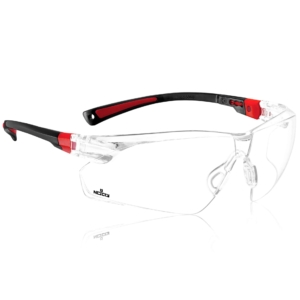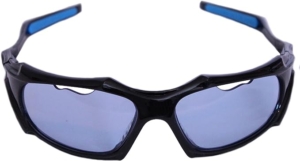So, my family of pickleheads, it’s time to “pickle your peepers” and gear up with protective eyewear! Let’s face it, we all want to play pickleball fearlessly, and nothing should hold us back from getting in front of those court smashers, returning with a soft dink, and winning those games.
Pickleball is a popular sport that has been gaining traction among players of all ages. As the game’s popularity soars, so does the awareness of the risks associated with playing without proper eye protection. I wrote this blog to explore the compelling reasons why protective goggles or eyewear should be mandatory in pickleball, and why players should prioritize the safety and health of their eyes while enjoying the game they love.
Now, some might argue that wearing goggles or glasses on the court may impede their vision and cramp their style. But trust me, it’s a small price to pay for protecting those precious peepers, this from a guy who has already had two sports-related retina detachments, and who discovered pickleball when my last operation sidelined my soccer playing days forever. When I was first introduced to the game, I was shocked at how many pickleball players don’t wear protection. Especially, when I experienced my lack of direction ( and the lack of many other newbies) on the courts. After all, pickleball is not just about winning a game; it’s about having fun, bonding with friends, and keeping those eyes healthy and happy for all the games yet to come.
The Perils of Playing Unprotected
Pickleball is a game that involves a hard plastic ball and swift paddle movements. The speed of the ball can be alarming, especially when it comes into contact with vulnerable soft tissue such as the eyes. Eye injuries can range from mild discomfort to severe retina detachment, which may require extensive surgery and prolonged recovery times. The risks are even more concerning for the average pickleball player, who tends to fall within the age range of 60-76, where eye injuries are less likely to heal quickly. According to the National Library of Medicine, “Proper eye protection should be strongly considered while playing pickleball, especially in the elderly population or in individuals who are at higher risk for retinal detachment.”
According to Pickleball Magazine, a pickleball can travel at one-third the velocity of a tennis ball or about 40 miles per hour. The magazine noted that when the players are positioned at the “no-volley line,” it can take 350 to 400 milliseconds – less than half a second – for the ball to travel from one paddle to the other. This does not leave players any time to avoid being hit in the eye with a ball. In addition to injuries from being hit by a ball, serious damage can occur from being hit in the eye with a paddle.
Numerous incidents of eye injuries have been reported in the pickleball community. One instance involved Allison Miller from Delta pickleball association in BC, who had her retina detached and required surgery after being hit by a whiffle ball during a game. Such stories underscore the urgency of implementing strict safety rules and mandatory eyewear usage. Recreational players are not the only ones that have had major injuries. This holds true even in the professional realm, as demonstrated by Jessie Irvine, a pro player who suffered a blow to the eye area during a recent tournament. Despite attempting to recuperate for several minutes, Irvine ultimately had to withdraw from the tournament bracket on that day and was unable to participate forcing her to completely exit the competition. These stories remind us that accidents can happen to anyone, but we can take preventive measures.

Retinal surgery is 100% avoidable with specs. just ask Allison Miller!
Why Players Are Reluctant to Wear Protective Eyewear?
While the need for eye protection is undeniable, some players are still hesitant to don goggles or eyewear. The most common concern is how it might impact their performance on the court. Players fear that the added gear may obstruct their vision or feel uncomfortable during intense, sweat-induced matches. Addressing these concerns and dispelling myths can help players realize that the benefits of wearing protective eyewear far outweigh any perceived drawbacks.
The Advantages of Embracing Eye Protection
- Fearlessness on the Court: Knowing that their eyes are safe allows players to focus solely on their game, leading to improved performance and confidence.
- Eye Strain Reduction: Protective eyewear shields the eyes from harmful UV rays and prevents squinting, leading to reduced eye strain from sun exposure.
- Windborne Debris Protection: Eyewear shields the eyes from debris that might be carried by the wind during outdoor games, preserving clear vision.
- Enhanced Depth Perception and Contrast: Proper eyewear designed for pickleball enhances depth perception and contrast, enabling players to track the ball with precision.
- Prevention of Eye Injuries: Protective eyewear significantly reduces the risk of severe eye injuries, including retina detachment or cornea scraping from stray balls.
- Reduced Risk of Paddle-Related Injuries: Protective eyewear also guards against accidental hits to the face from paddles, preventing potential injuries ( I saw this happen recently when a paddle flew out of the beginner’s hand and hit her partner in the back).
Selecting the Right Eyewear for a Perfect Fit (or as close to perfect!)
When choosing protective eyewear for pickleball, several key factors should be considered. These include impact resistance, anti-fogging, anti-glare, and UV resistance. Additionally, players with prescription needs should look for options that allow for prescription lenses. A snug and comfortable fit is essential to ensure a hassle-free experience during play. Try to get as close to a perfect fit as possible. This is very important because you don’t want to buy something that will give you a hard time while playing the game. The glasses shouldn’t be too loose or too tight. They should be as close to the perfect fit as possible. Now I buy inexpensive but really efficient eye protection to protect my eyes, although they don’t really offer me a better vision on the court, I feel safe getting in front of those balls from smashers. I use simple construction safety glasses that offer me clear UV lenses, fit well, are super durable, and best of all cheap enough that I always have extra pairs for my friends or newcomers that show up to play with me. However, if buying Pickleball gear from Home Depot doesn’t float your boat then here are some brands to consider when buying eyewear. For players seeking quality eyewear that are more than adequate for pickleball, several renowned brands offer an array of options.
These include:

Effective and inexpensive!
- NoCry Safety Glasses: Clear Anti-Fog Scratch Resistant Wrap-Around
- ONIX Pickleball Owl Eyewear: Modern and Lightweight Design
- Unique Tourna Specs: Blue Tint Sports Glasses for Tennis and Pickleball
- Gearbox Vision Eyewear
- ONIX Pickleball Falcon Eyewear: Modern and Lightweight Design
- Python Full Framed Racquetball Eye Protection
- Bollé Safety 40305 Tryon Safety Glasses: Platinum®, Black/Blue Frame, CSP
- Gearbox Vision Racquetball, Pickleball, Squash Eyewear
- Python Full Framed Racquetball Eye Protection: Clear Lens/White Frame
- Pyramix Highlander wrap around
PS I haven’t tried all of these products but I did take the time to see what other players are wearing and get feedback. These were the brands I chose from my local groups, considering the price, availability, and quality of my selections. My goal is to inform and get eyewear onto as many players as possible!
In my humble opinion, eye protection is a paramount concern for pickleball players. The risks associated with playing unprotected are too great to be ignored. I strongly believe that mandating the use of protective goggles or eyewear is a necessary step to safeguard the eyes of pickleball enthusiasts, especially older players, who may be more vulnerable to eye injuries. Players must prioritize their eye health and well-being, understanding that wearing protective eyewear not only prevents injuries but also enhances their performance on the court. With the variety of eyewear options available, players can find a perfect fit that combines safety, comfort, and vision enhancement. So, let’s all come together as a community, embrace the importance of eye protection, and make it a firm rule in our games. Let’s pickle our peepers and savor the joy of pickleball without the fear of eye injuries looming over us. We owe it to ourselves, our friends, and the pickleball community to take this step toward safe and inclusive play.
My fellow pickleheads, I really believe it’s time to smash the notion that protective eyewear is just an optional accessory! It’s a game-changer, a sight-saver, and a must-have on the pickleball court. So next time you step on the court, remember to “serve, smash, and shield your eyes” – because in pickleball, protecting your vision is a NO brainer! Let’s keep the game fun, fierce, and injury-free. See you on the court, with goggles on and spirits high!
Yours in Pickleball, Chris

Vented to reduce the fog of pickleball fun!




 open commons
open commons 







